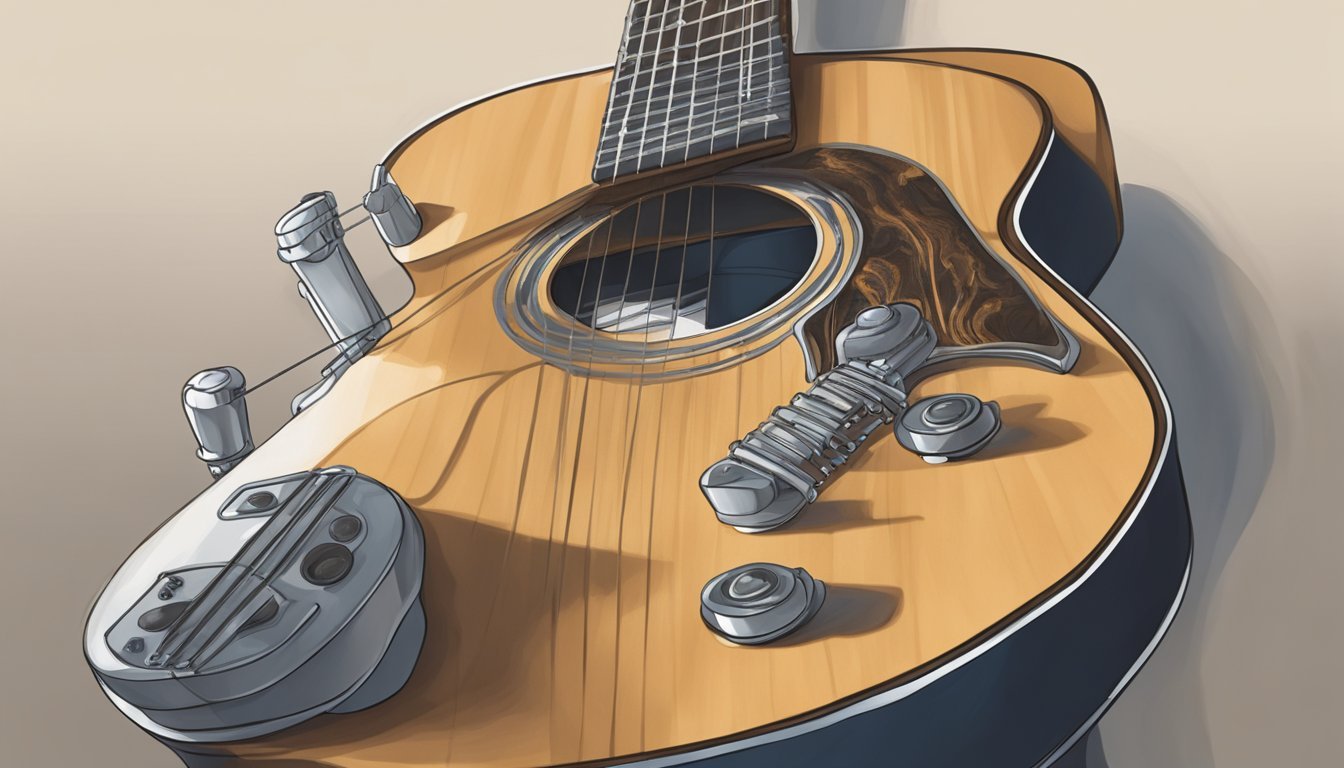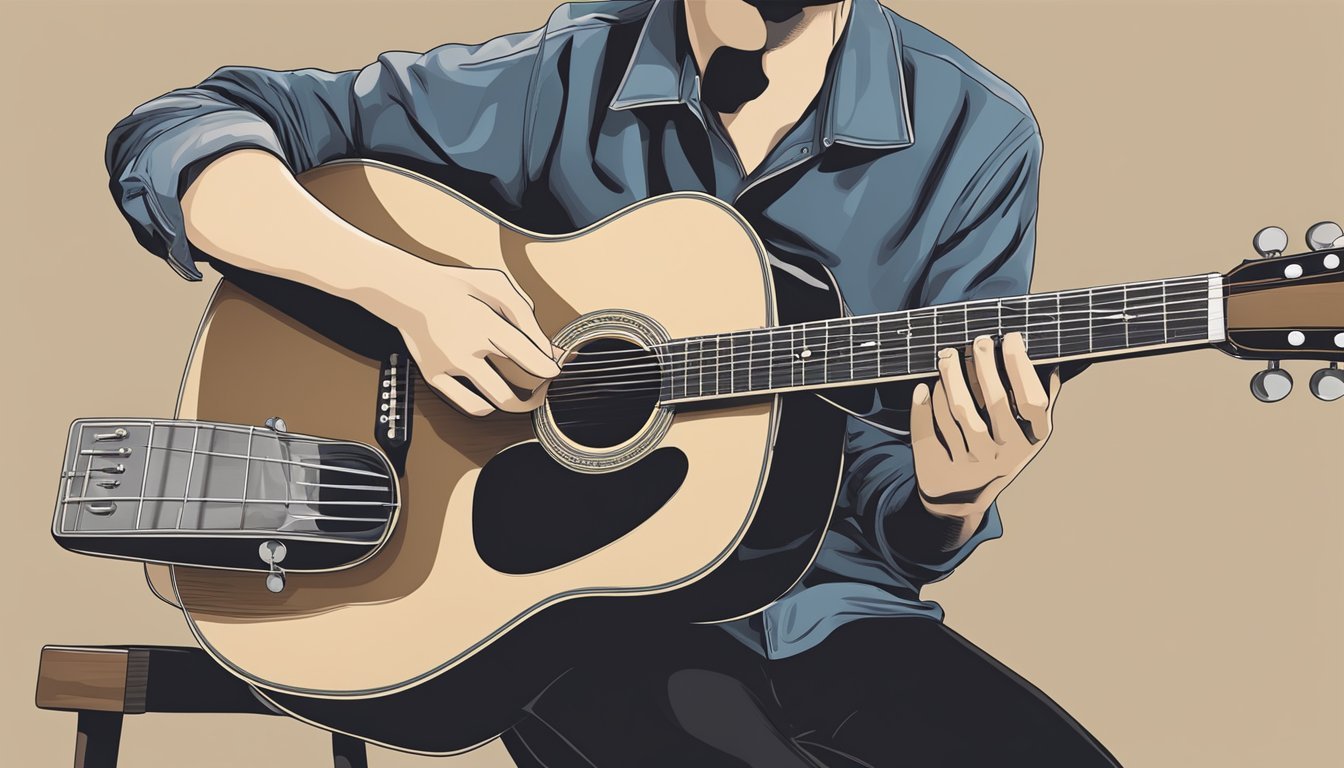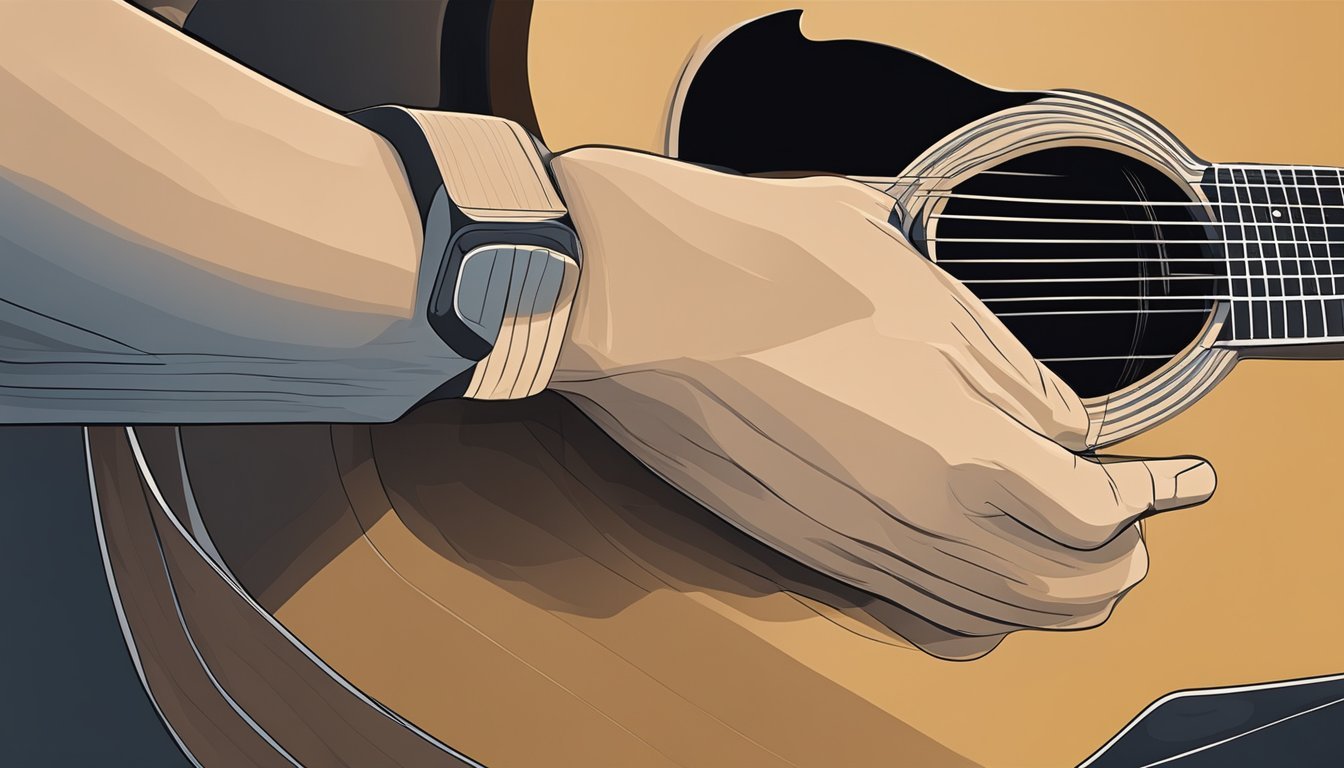Holding an acoustic guitar the right way is essential for comfortable and effective playing. To hold an acoustic guitar properly, sit up straight with the guitar resting on your thigh. This position helps distribute the weight evenly and allows you to reach the strings and neck with ease.
Whether you’re strumming along to your favorite songs or learning chords, knowing the proper posture can make all the difference.

As you get started, you’ll discover that hand positioning impacts your ability to play well.
It’s not just about how you hold the guitar; it’s also about how your hands interact with it.
Adjusting your grip and finger placement can enhance your playing experience, making it easier to learn and enjoy the music you create.
With the right setup, you’ll feel more confident and ready to dive deeper into your guitar journey.
So, let’s explore how to hold your acoustic guitar for the best playing experience! First and foremost, it’s essential to understand how to hold an acoustic guitar properly to avoid discomfort and enhance your playing technique.
Ensure that the body of the guitar rests comfortably against your thigh, and position your left hand on the neck, allowing your fingers to navigate the frets with ease.
By mastering how to hold an acoustic guitar, you’ll not only improve your posture but also maximize your ability to express your musical creativity.
Key Takeaways
- Sit up straight with the guitar resting on your thigh.
- Pay attention to how your hands are positioned on the strings.
- Proper posture helps improve your overall playing technique.
Setting Up the Guitar

Getting your guitar set up right is important for comfort and ease of play.
The first thing to consider is the size of your guitar.
Then, you need to adjust the strap to make holding it more comfortable.
Choosing the Right Guitar Size
Choosing the right guitar size makes a big difference in how easily you can play.
Acoustic guitars come in various sizes, like full-size, ¾, and ½, to fit different body types and ages.
- Full-size guitars: Great for adults or taller players. They provide a full sound but can be bulkier.
- ¾ size guitars: Good for teens or players who find full-size guitars hard to handle.
- ½ size guitars: Suitable for children or players with smaller frames.
Try holding different sizes to find out what feels right for you.
The guitar should be comfortable against your body.
If you feel strained while reaching the fretboard, it might be too big.
Adjusting the Guitar Strap
A good guitar strap helps you hold your guitar properly.
When putting on your strap, make sure it’s adjusted to the right length.
- Length: The strap should allow the guitar to rest comfortably against your body. Your fretting hand should be able to reach the neck without stretching too much.
- Position: When playing, the body of the guitar should sit around your waist or slightly higher, depending on your preference.
Check that the strap is secure and isn’t slipping.
This ensures that you can focus on playing without worrying about your guitar sliding down.
Adjustments might take a few tries, so take your time to get it just right.
Finding the Correct Sitting Position
Getting the right sitting position is key to playing your acoustic guitar comfortably and effectively.
A good position helps you maintain proper posture and makes it easier to access the strings and frets.
Positioning the Guitar on Your Lap
First, sit on a chair with your feet flat on the ground.
Keep your back straight and shoulders relaxed.
You want to choose a chair that allows you to sit up straight without sinking too low.
Next, place the waist of the guitar on your dominant leg.
If you’re right-handed, this means resting it on your right leg.
This not only supports the guitar but also positions it at the right angle for playing.
Tilt the neck of the guitar slightly upwards so you can see the fretboard clearly.
Make sure your fretting hand can easily reach the neck without straining.
Keeping the guitar stable will help you focus on your playing without unnecessary distractions.
Using a Footstool for Support
A footstool can help improve your posture and comfort while playing.
It raises your foot, which brings your guitar into a better position.
This is especially useful if you find it hard to balance the guitar on your lap.
To set up your footstool, place it under your dominant foot.
This angle helps keep your back straight while giving you easy access to the strings.
Make sure it’s a comfortable height based on your leg length.
When using a footstool, ensure your guitar stays stable.
Your leg will act as a base, which means you need to grip the guitar gently but firmly.
This will help you play for longer periods without discomfort.
Mastering Hand Positioning
Getting your hand positioning right is key to playing acoustic guitar effectively.
It can make a big difference in how comfortable you feel and how well you play.
Let’s break down how to place your fretting hand and optimize your strumming hand.
Placing the Fretting Hand
Your fretting hand, usually your left hand if you’re right-handed, is crucial for playing chords and notes.
Start by keeping your wrist relaxed; a stiff wrist can cause tension and make playing difficult.
Finger Placement:
- Your fingers should curve naturally.
- Aim to use the tips of your fingers to press down on the strings.
- Try to position your first finger across the second fret for ease of access.
Ensure your thumb is behind the neck for support.
This position helps you reach different frets without straining.
If you find yourself hovering or stretching too much, adjust your wrist and arm for better angles.
Optimizing the Strumming Hand
Your strumming hand needs its own attention, too.
The way you hold it impacts your sound and control over the strings.
Arm Position:
- Let your strumming arm rest comfortably over the guitar, keeping a relaxed posture.
- Your hand should be above the sound hole; this placement helps create a fuller tone.
Strumming Technique:
- Use a loose wrist and rhythmic motion to strum.
- Let your fingers lightly brush across the strings, which gives better control.
- Practice strumming down and up to find a comfortable rhythm.
By fine-tuning both hands, you’ll improve your overall playing and enjoy your guitar journey more.
Adopting the Standing Position
When you’re ready to play your acoustic guitar while standing, it’s important to find the right balance and maintain good posture.
This will help you play comfortably and sound better.
Balancing the Guitar on Your Body
To balance the guitar correctly, use a strap.
This helps you hold the guitar without straining your arms.
Adjust the strap so the body of the guitar sits comfortably against your torso.
Aim for a position where the neck is slightly tilted upward.
This angle makes it easier to reach the frets.
Make sure the guitar is not too high or too low.
If it feels awkward, adjust the strap again.
Keep the weight evenly distributed.
You should feel stable and not have to lean to one side.
This balance allows you to move freely and play more confidently.
Maintaining Good Posture
Good posture is key when holding a guitar.
Stand with your feet shoulder-width apart and your back straight.
Avoid slouching, as this can cause discomfort and affect your playing.
Keep your shoulders relaxed and down, not hunched.
Your arms should hang naturally when you strum.
This alignment not only helps you play better but also prevents fatigue.
Breathe easily and stay relaxed.
Tension in your body can lead to poor guitar posture.
Focus on staying comfortable as you play, so your music flows naturally.
Frequently Asked Questions

Holding an acoustic guitar correctly is important for comfort and playing ability.
Here are some common questions that can help you get a better grip on your acoustic guitar technique.
What’s the right way to hold an acoustic guitar if you’re a beginner?
As a beginner, sit up straight and rest the guitar’s body on your right thigh if you’re right-handed.
Keep the neck tilted slightly upwards, which makes it easier for your left hand to reach the frets.
Can you give me a rundown on how to hold an acoustic guitar if you’re right-handed?
If you’re right-handed, place the guitar on your right leg with the back of the guitar against your body.
Your right arm should drape over the top of the guitar, and your left hand should be free to move up and down the neck.
Is there a proper way to grip an acoustic guitar pick?
Hold the pick between your thumb and index finger.
Try to grip it firmly but not too tight to avoid strain.
Make sure you have enough pick showing to strum comfortably, usually about half an inch.
Got any tips for holding an acoustic guitar comfortably as a woman?
If you’re a woman, consider how the guitar’s body rests against your body.
Try adjusting your position so the guitar curve fits snugly with your waist or thigh.
You can also use a strap to provide extra support.
How should you hold your acoustic guitar when you’re playing without a strap?
Without a strap, keep the guitar close to your body.
Use your right arm to hold it in place while you play.
This will help prevent it from slipping and keep your hands free for strumming and fretting.
What are the common mistakes to avoid while holding an acoustic guitar?
Avoid gripping the neck too tightly with your fretting hand.
Gripping the neck too tightly can cause tension and fatigue.
Also, don’t let the guitar slide too far away from you.
This makes it harder to reach the strings comfortably.

